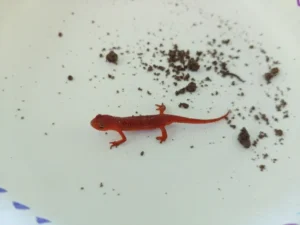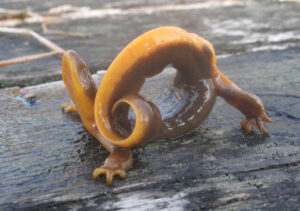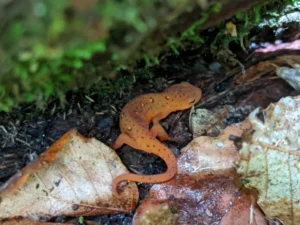Have you ever seen a small, brightly colored creature in a pond or under damp leaves and thought, “Is that newt really orange?”
Yes, some newts are orange. The bright orange often shows on their bellies or sides. It can warn predators, signal health, or even help them blend in. Color can change by species, age, or season, so each newt is a little different.
How Newts Get Their Orange Color
Newts don’t just magically turn orange. Their color comes from special pigments in their skin called chromatophores. These pigments make shades from yellow to deep orange.
Sometimes the orange is only on the belly or sides, while the back stays darker to help hide from predators.
For example, the Eastern newt has a bright orange juvenile stage called an eft. These efts are tiny and fully orange, standing out in the forest.

Later, as adults, their backs darken while the belly stays orange.
Color isn’t just about looking pretty. It can show health, warn predators, or attract mates.
A dull or faded orange might mean the newt is sick or stressed, while a bright orange shows it’s strong and healthy.
Why Some Newts Have Orange Bellies
Have you noticed that in many species, only the belly is orange? This is actually a clever trick. Predators often attack from above.
A darker back helps the newt blend with the ground or water, while the orange belly warns predators if the newt flips over.
This is called aposematic coloring, a natural “stay away” signal. For example, the rough skinned newt is famous for its bright yellow belly.

If a predator tries to eat it, the newt arches its back and flashes the warning color. Many predators think twice before biting.
Do All Newts Turn Orange?
Not all newts are orange. Colors can vary a lot:
-
Smooth newts: Usually brown or green on top, sometimes a pale orange belly.
-
Great crested newts: Dark backs with a yellow-orange belly and black spots.
-
Eastern newts: Bright orange efts, darker adults with orange bellies.
Season and age matter too. Young newts often have brighter colors, while older ones may fade. Sunlight or diet can also make the orange stronger or weaker.
Orange Can Be a Warning or Camouflage
Why would a small newt risk standing out with bright orange? Actually, it’s a smart strategy. The bright color warns predators that the newt might be toxic.
Some newts make skin toxins that taste bad, so the orange says “stay away.”

At the same time, when seen from above, many orange-bellied newts blend with the forest floor or pond bottom, especially in autumn when leaves turn orange and brown.
Orange can help in two ways: hiding and warning.
How Orange Helps During Mating
Color is also important for newts during mating. Males sometimes have brighter orange patches in breeding season. This makes them more noticeable to females and shows they are healthy.
In courtship displays, males show off these colors while performing dances in the water. Females often choose mates based on how bright and strong their orange markings are.
It’s like a natural spotlight saying, “Pick me, I’m healthy and ready!”
Can You Tell a Newt’s Health by Its Color?
Yes! Color can show health. A healthy newt usually has:
-
Bright, even color
-
Shiny skin without dull patches
-
Clear, vivid patterns
A dull or faded orange might mean stress, poor diet, or sickness. Predators in the wild may notice these changes and avoid weaker newts, helping the strongest survive.
Are Orange Newts Poisonous?
Many orange newts are mildly toxic. The orange acts as a warning, telling predators: “Don’t eat me.”
The toxins are usually not dangerous to humans if handled carefully, but they can irritate skin or eyes.

For example, the eastern newt secretes toxins from its skin. A predator that bites it might get a bad taste or mild discomfort.
Over time, predators learn to link bright orange with something unpleasant, keeping the newts safe.
Do Orange Newts Change Color?
Newts can sometimes change how bright their orange is, depending on mood, temperature, or season.
During breeding season, males may look brighter to attract females. When hiding or resting, the color can look duller.
Temperature matters too. In cooler ponds, colors may be less bright, while in warm, sunny conditions, the orange can really pop.
This flexibility helps newts survive in different environments.
Conclusion
So yes, some newts are orange, and that color is really important. It can warn predators, help with mating, and even hide the newt depending on where it lives.
The shade, location, and brightness of orange can tell you a lot about the newt’s species, age, health, and even season.
Next time you see a little orange belly or a bright eft in a damp forest, take a moment to watch.
That small splash of color tells a story of survival, health, and natural cleverness, all wrapped in a tiny amphibian’s smooth skin.
Hi, my name is Ezra Mushala, i have been interested animals all my life. I am the main author and editor here at snakeinformer.com.

